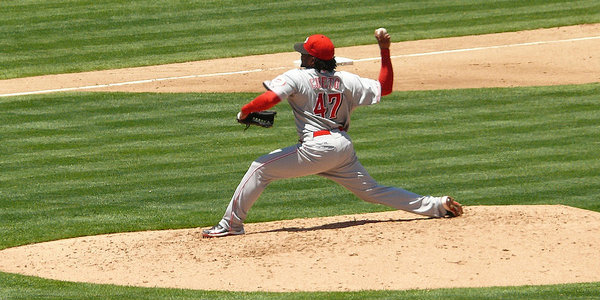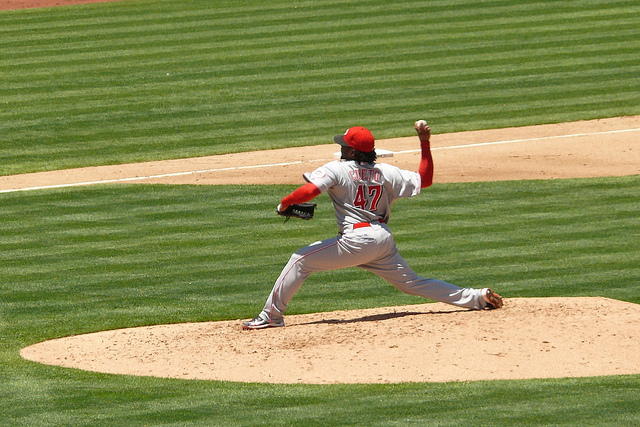2014 Fantasy Baseball: Who Has Beaten Their Peripherals Lately?

Yesterday, I posted a piece about Julio Teheran. I didn’t mention WAR in it, mainly because it was a fantasy piece and your league settings likely mean the statistic doesn’t mean much for you in this context. Teheran’s WAR, however, was in the back of my mind the whole time. Mainly because there has been such a discrepancy between his raw, more traditional stats and his peripherals this season.
Surely you’ve heard about the different formulations WAR has. Fangraphs uses FIP, among other things part order to get fWAR. Baseball Reference, on the other hand, uses a formula that bases that stat on the amount of runs a pitcher allows. Fangraphs also has something similar – RA9-WAR.
Most of the time, I find myself using regular, ole fWAR. It’s on the leaderboard. It’s convenient. And most of the time I pay more attention to FIP than ERA; especially this early in the season. But Teheran’s case made me curious.
You may be asking yourself, does it really make that big of a difference? In some cases, yes. Most of the time, ERA tends to fade towards FIP. The two grow closer and closer as sample sizes grow. The point of FIP, after all, is to estimate what a pitcher’s ERA should have been. And since FIP is baked into WAR… well you get the point.
Some pitchers, however, have made a habit out of “beating” FIP and thus performing better according to RA9-WAR. Tom Glavine comes to mind – 88 RA9-WAR; 64.3 fWAR. Tim Hudson, too – 65.4 RA9-WAR; 49.3 fWAR, as of this writing. Glavine and Hudson did things similarly. We don’t have batted ball data for most of Glavine’s career, but he pitched to contact. He wanted the ball to be put in play so that he was able to pitch deeper into games. Hudson is of the same mold. His ability to coax grounders limits the amount of damage balls in play can do, so he begs hitters to swing the bat. If you want one more classic examples: Greg Maddux was better based on runs allowed.
So far, Teheran has outperformed his peripherals in his career. He’s done so by wiggling out of trouble, whether it’s upping his strikeout rate with runners on or picking someone off, he’s done it. But who’s done the best job beating their peripherals over the past couple of years?
| Name | Team | RA9-WAR | WAR | Difference |
|---|---|---|---|---|
| Bronson Arroyo | – – – | 13.9 | 5.3 | 8.6 |
| Jered Weaver | Angels | 28.8 | 21.5 | 7.3 |
| Johnny Cueto | Reds | 20.4 | 13.3 | 7.1 |
| Tim Hudson | – – – | 17.7 | 11 | 6.7 |
| Matt Cain | Giants | 22.4 | 16.6 | 5.8 |
Since 2009 it’s been Bronson Arroyo. Not shocking. For years he’s gotten by on deception – changing his arm angle a ton during games and seemingly wiggling out of everything. He beat the regression monster for awhile, but that’s no longer the case. He’s been pretty bad this year and for once he’s underperforming his FIP. Jered Weaver has done it for years, too. Weaver’s been able to accomplish this feat mostly because of deception and wiggling out of trouble by inducing a lot of harmless pop-ups (8th highest IFFB% since 2009). Ditto for Matt Cain on the pop-ups, at least until the last year and a half. We touched on Hudson above. Cueto is the interesting name here. His strikeout rate has jumped a ton this season, but he’s still beating his FIP by more than a run.
Over the past two seasons Cueto has been able to outpitch his FIP thanks to ground-balls and being impossible to steal on. During Cueto’s career, 28% of would be base-stealers have been thrown out. But when Cueto has been on the mound, 65%(!) have been caught. He’s allowed 17 stolen bases in his career – a career that encompasses over 1,000 innings. Cueto’s been a master of wiggling out of trouble, it’s not hard to do when teams give away outs at that high of a rate.
The differences in WAR boil down to this for me: I usually side with fWAR, mainly because I believe it’s best for small samples. But in some cases, I believe in a guy that consistently beats his FIP. Cueto’s incredible ability to keep the running game in check changes the equation a little. That ability has a domino effect. Runners have to be more careful. Perhaps they miss out on taking an extra base because they have to pay more attention to Cueto, and then the next batter grounds out. Who knows? Some pitchers are underrated by fWAR, just like some guys might be overrated a tad.
Lastly, some pitchers are also just really good at inducing weak contact, so they’re able to pitch to contact more, and their peripherals suffer a little. Unfortunately, we don’t have a good way to test that at the moment, but hopefully we will soon. Cueto might be one of those guys. Kris Medlen, another guy who beat his FIP for two years before succumbing to injury, also seemed to induce a ton of weak contact.
Either way, different strokes for different folks. Sometimes it’s just fun to look at why the numbers might differ a little.
Julio Teheran, who sparked all of this, has beaten his FIP over the past two calendar years. Because of this, he’s only racked up 3.2 fWAR compared to 5.9 RA-9 WAR. He, like Cueto, has gotten extra outs on the base paths. Perhaps Teheran is the next pitcher to consistently beat his FIP? Time will tell, as always.






